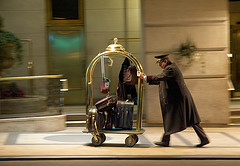 In both the U.S. and abroad, transportation providers of all kinds have rules governing bags that are checked in and carried on.
In both the U.S. and abroad, transportation providers of all kinds have rules governing bags that are checked in and carried on.
Here are 5 things every traveler should know about taking baggage on a trip.
1. Know the baggage rules for your carrier
Heightened security measures since 9/11, the attempted shoe-bombing, and other threats, have made the rules for what can go into your baggage and what be put on an airplane very strict. Add to that the airline charges for checked and sometimes for carry-on baggage, and you’ve got some of the highest points of frustration for travelers.
Knowing the baggage rules should be simpler than it is, but it’s not. First, there are the TSA baggage rules which are complicated and exhaustive, and then there are the airline-specific rules, which vary from airline to airline and cover:
- The number of items you can carry on (2 is usually the maximum)
- Each bag’s size and weight
And finally, there are the exceptions to what can be carried on: breast milk, baby formula, and medicine in amounts that exceed the liquid limits, for a few examples. If you’re carrying anything even a little out of the ordinary, check the websites of the airline and the TSA to learn how to get that item onto and safely off the airplane.
Of course, the airlines aren’t the only ones with baggage restrictions. Amtrak baggage rules, for example, have restrictions similar to those of the airline: limiting the number and sizes of your carry-on and checked bags as well as restrictions on what can go into your bags – no firearms, ice picks, and hazardous chemicals are a few). Be sure to check the websites of the non-airline transportation providers for their rules too.
2. Know what the airlines owe you
The treatment of checked baggage is a constant source of traveler complaints and for good reason. While the airlines claim that the rate of lost luggage is always improving, it makes no difference to the person standing alone at the empty baggage carousel.
If an airline loses a traveler’s bag and belongings, that person can file a claim. The Department of Transportation (DOT) requires the airline to compensate the traveler for the value of the bag and its contents up to a maximum of $3,300, but here’s where things get tricky:
- The airlines have maximum limits for single items, so if you have a lot of old clothes but $5,000 worth of camera equipment, you’re not going to be happy with the payout.
- The airline will require proof of the value of everything in the bag and that means receipts for everything, including the bag.
- Then they’ll apply depreciation scale to everything you claim was in the bag.
It’s for this reason, we recommend you photograph the contents of your luggage before a trip – it can provide a little support to your claim. We also recommend you follow these rules to protect yourself from losses:
- Never pack anything that can’t be replaced in your checked baggage
- Never pack anything that you can’t live without in your checked baggage
It’s hard to say when a bag is well and fully ‘lost’ and not just gone on a different trip than the one you have, so delayed baggage is also a problem. Bags lost for 21 days after landing abroad qualify as lost. The DOT requires the airlines to pay something to the traveler whose bags are delayed, but the airlines are largely left to make their own rules and publish them online.
3. Know what your travel insurance will cover
Most travel insurance plans – even those identified as travel medical plans – offer some level of baggage coverage, which can be more useful on a trip than you might think. For one thing – your baggage coverage is in effect whenever your bag is lost, destroyed or stolen so it’s not isolated to the plane trip.
Of course, baggage coverage with your travel insurance plan also comes with some pretty hefty restrictions, including per-item, per-person, and other limits.
Baggage coverage for truly lost bags is nearly always bundled with coverage for bags that are currently missing so if you’ve got one, you likely have both types of coverage.
- See our review of baggage coverage for the full details, including what’s covered and what’s not.
- See our review of baggage delay coverage for the full details on that type of coverage. Again, we include what is and isn’t covered
4. Purchase additional coverage for high-value items
While we always recommend keeping your high-value items on your person or in your carry-on it’s not always an option for every traveler, so we tracked down how you can best protect those items from loss, damage, or theft.
Some, but not all, airlines allow you to purchase additional coverage if the possessions you are checking are valued in excess of the airline’s standard compensation.
Some items – cameras, jewelry, electronics for instance – can be more fully covered by adding them to your homeowner’s insurance policy. Often this means a special rider and an additional premium, but the item will be fully covered and you won’t experience the per-item limits you see with airline coverage and baggage coverage with your travel insurance plan.
5. As a last resort … or perhaps the first
If you have to send something very expensive or very important from here to there, consider packaging it and mailing it with appropriate insurance cover to it’s destination. Often, circumventing the transportation rules is the best way to get out of this mess entirely.
